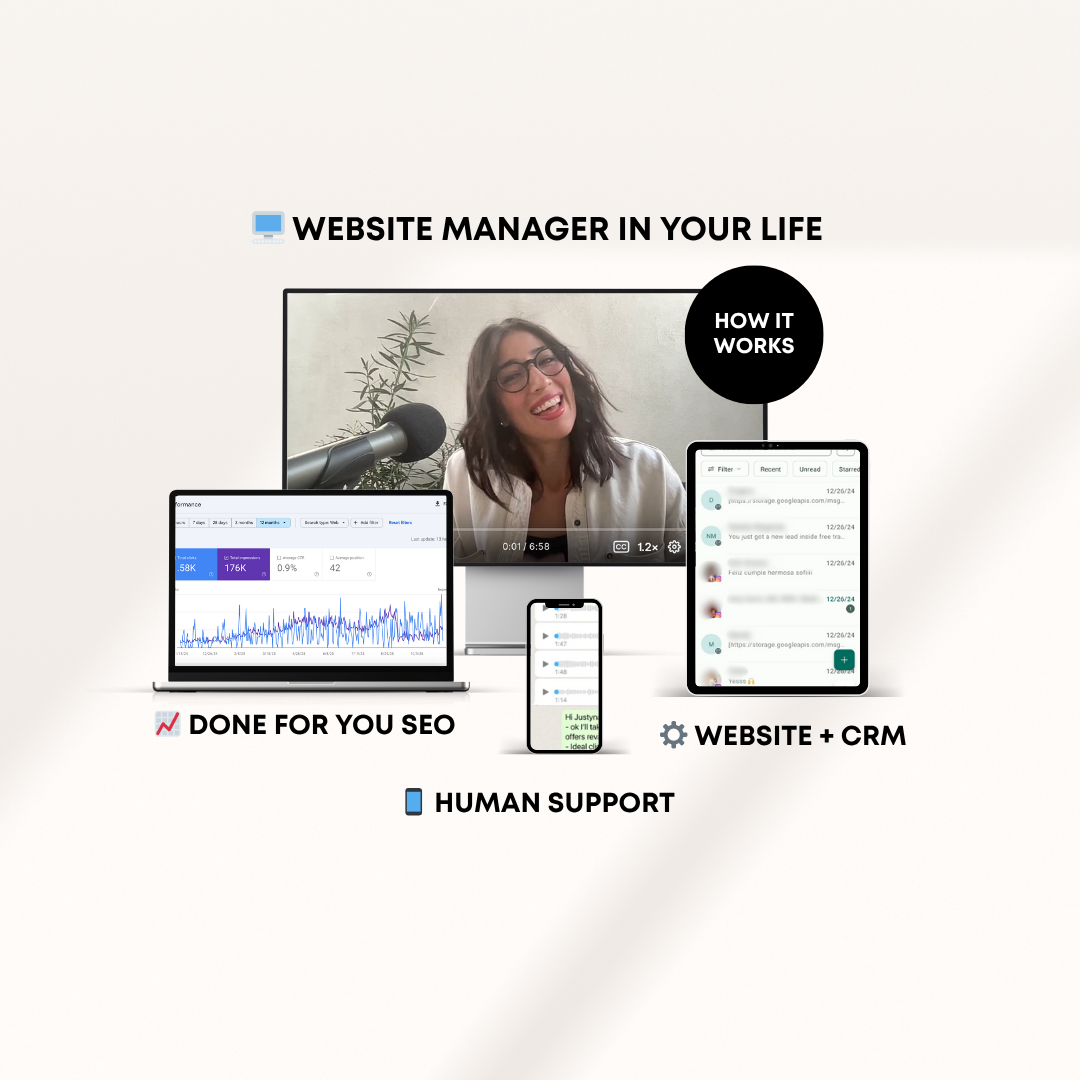How to Know If Your Private Practice Marketing Is Actually Working + KPI tracker
Most therapists aren’t short on effort, they’re short on feedback. You’re showing up, creating content, and updating your site, but without clear data, it’s hard to know what’s actually moving the needle.
That’s where KPIs come in. Instead of guessing, you can track the metrics that matter—so you know what’s working, what’s not, and where to focus next. Because without that clarity, even the most aligned marketing can feel like shouting into the void.
To make it easier, I created afree KPI & SEO tracker designed specifically for therapists and wellness professionals. It’s a simple tool to help you get clear on your numbers—so you can grow with intention (and without the overwhelm).
If we haven’t met yet, I’m Natalia—awebsite designer for therapists. I help private practice owners like you clarify their message, simplify their marketing, and build websites that work like steady, behind-the-scenes referral partners.
In this post, we’ll unpack the KPIs that actually matter in private practice marketing—so you can make confident decisions, optimize your strategy, and finally see results you can trust.
How to market your private practice successfully
You don’t need to be everywhere to grow your practice—you just need a few aligned strategies that feel good and actually work.
Let’s keep it simple:
What you don’t need:
- A viral TikTok strategy (if that’s not your thing)
- Posting on Instagram every single day
- Writing 3 newsletters a month just to keep u
What actually helps:
- A clear, empathetic website that builds trust
- An optimized profile on Psychology Today or TherapyDen
- A blog that answers the exact questions your clients are already Googling
When your marketing aligns with your energy, your values, and your ideal clients, it becomes sustainable. Not louder—just smarter.
What it really means to work in private practice
Running a private practice means wearing all the hats—not just as a therapist, but also as the admin, the marketer, and the tech support.
That’s why your marketing shouldn’t feel like another full-time job.
Instead of chasing trends or overextending yourself, think of marketing as an extension of your work:
- A website that speaks for you, even when you’re offline
- A blog that gently educates and connects
- A freebie that builds trust before a client ever reaches out
You don’t have to become someone else to be visible.
You just need tools that help the right people find
you.
Which marketing channels work best for therapists
Not all marketing channels are created equal—especially when you’re holding space for others all day and don’t have the energy to be everywhere at once.
Here’s what actually supports long-term growth (without the burnout):
1. Your website
Your website is your virtual office—the first place potential clients visit to decide if you’re the right fit. It should clearly answer: who you help, how you help, and how to get started. When done well, it builds trust before they ever hit “send” on a contact form.
2. Google Business Profile
Your Google profile is often what shows up first when someone searches “therapist near me.” Keeping it updated with photos, clear service categories, niche keywords, and reviews boosts your local visibility and builds instant credibility.
3. Online directories
Platforms like Psychology Today, TherapyDen, or Inclusive Therapists can bring in traffic—but only if your profile stands out. Write for your ideal client (not your colleagues), use relatable keywords, and communicate in a warm, accessible way.
4. SEO and blogging
SEO is about knowing how your ideal clients search and creating content that helps them feel seen. Posts like
“what to expect in your first therapy session” can quietly attract the right people for months—without requiring you to constantly be online.
5. Email marketing
Email is your steady connector. A simple monthly newsletter or resource drop-in helps you stay top of mind, even when someone isn’t ready to book. You don’t have to be a “writer”—just a human offering something thoughtful.
6. Social media
Social media can support community and share your voice, but it shouldn’t carry your entire marketing strategy. You don’t need to post daily or go viral. Focus on what feels sustainable and genuine.
The 3 phases of private practice marketing growth
You don’t need to do everything all at once. Your marketing can grow in phases—and each one builds on the last.
Phase 1: Online presence and visibility
This is your foundation. Before posting on social media or starting a blog, you need a digital home base that clearly guides people toward working with you. A well-designed website isn’t just about looking professional—it’s about helping potential clients move from curiosity to clarity.
When someone lands on your site, they should instantly understand who you help, how your process works, and what their next step is. Once your site is in place, the next step is discoverability. That includes claiming and optimizing your Google Business Profile, creating standout listings on directories like Psychology Today, and using keywords that your ideal clients are actually searching for.
This is one of the areas where I offer the most support—building websites that quietly work in the background, bringing in aligned inquiries every day.
Phase 2: Content marketing and networking
Once your foundation is solid, it’s time to share your voice. That might mean writing blog posts that answer your clients’ most common questions, collaborating with trusted colleagues, or speaking at virtual summits.
This is where you expand your visibility and reinforce it with social proof—testimonials, reviews, and outcomes that speak for themselves. At this stage, many therapists start to hear things like, “I’ve come across your name a few times—I think you’re the one.”
Phase 3: Referrals and community building
Now your marketing begins to support itself. Instead of constantly putting yourself out there, you start receiving referrals from past clients and trusted peers. The content you’ve created—blogs, lead magnets, workshops—continues to attract inquiries without requiring constant output.
This is the sustainability phase. It’s when your systems, visibility, and relationships start doing the heavy lifting, giving you more time to focus on your clients and your life outside of work.
Marketing doesn’t have to be overwhelming or performative. It can be a slow, steady build that fits your energy, your values, and your season of life. If you’re ready to create a website that becomes a consistent, aligned source of visibility and connection, I’d love to help. Let’s build your foundation with clarity and strategy from the start.
Key metrics and KPIs for private practice marketing
Let’s shift from guessing to tracking. You don’t need to become a data analyst—but if you want to build a marketing strategy that actually works, you need to know what’s worth your time and energy.
Here’s what I recommend focusing on:
You don’t need to track everything—just what brings clarity and direction. Here are the KPIs worth focusing on:
- Website traffic – How many people are visiting your site, and where are they coming from?
- Bounce rate & time on site – Are visitors staying to explore, or leaving quickly?
- Top-performing pages – Which pages get the most traffic (and why)?
- Email list growth – Are people signing up for your freebie or newsletter?
- Inquiries & conversions – How many visitors are reaching out and becoming clients?
- SEO keyword rankings – Are you showing up on Google for relevant search terms?
Start by tracking 3–5 metrics that align with your current goals. Want a simple way to organize it all? Download my free KPI Tracker to make your next marketing review easier and more insightful.
How to measure and improve your marketing ROI
In private practice, ROI isn’t just about revenue—it’s about clarity, time saved, and marketing that supports your energy.
Strong ROI looks like fewer no-shows, steady inquiries, and visibility that builds while you’re offline. And the way to get there isn’t by doing more—it’s by tracking what actually matters.
When you look at your KPIs—like which content drives traffic or where your best leads come from—you can make aligned, data-informed decisions that reduce second-guessing and help your practice grow sustainably.
Your private practice deserves more than guesswork.
When you stop measuring success by likes and start looking at the numbers that actually matter, everything shifts.
Your website can become your best marketing tool. Your content can attract dream clients while you rest. And your visibility can grow without burning you out.
If you’re ready for marketing that’s grounded, clear, and built to work while you do the work that matters, explore my web design services for private practice professionals and therapists.
And before you go—download your free KPI & SEO tracker so you can finally see what’s working (and do more of it).
* AI Disclosure: This content may contain sections generated with AI with the purpose of providing you with condensed helpful and relevant content, however all personal opinions are 100% human made as well as the blog post structure, outline and key takeaways.
* Affiliate Disclosure: Some of the links on www.nataliamaganda.com may contain affiliate links meaning that I will get a commission for recommending products at no extra cost to you.

hello! i'm natalia
Latina, web design expert for mental health professionals.
I help ambitious life coaches, therapists and holistic leaders amplify their magic, gain visibility, and simplify their marketing efforts through strategic web design and content.
If you’re looking for an all-in-one system to manage your website, emails, funnels, and CRM, Go HighLevel (affiliate link) is the most powerful tool I’ve tested—and it’s built to grow with you.
On a tighter budget or just starting out? ThriveCart (affiliate link) offers a one-time payment option and easy checkout setups that still pack a punch for digital offers and automation. (Send me an email after your purchase and make sure to use my affiliate link)







